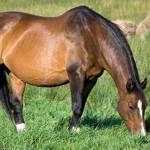Ultrasonography for Healthy Mares and Foals

Mares require veterinary care throughout pregnancy to ensure well-being. These examinations help identify potential issues, allowing owners time to make changes in management to benefit the mare and her developing foal. Examples include (1) identification of changing needs to their hoof care and (2) dietary energy modifications to ensure she is not over- or underfed during gestation, and (3) nutritional supplements such as joint supplements to support musculoskeletal health and omega-3 fatty acids, like E-O3, that benefit both the mare and developing foal.
“During these examinations, your veterinarian may use transrectal ultrasonography to visualize the foal and make various measurements,” explained Laura Petroski-Rose, B.V.M.S., a staff veterinarian for Kentucky Equine Research.
Many equine veterinarians specializing in reproduction own the traditional two-dimensional (2D) ultrasonography units to confirm pregnancy and evaluate the foal early in gestation. Mirroring advances in human medicine, some have upgraded to three-dimensional (3D) units to assess crown-rump length and fetal volume.
Being a rather new modality to veterinarians, little data exists to guide its use in everyday practice. To determine whether or not 3D ultrasonography can reliably assess fetal volume, an indicator of fetal size and growth, researchers obtained images from 149 Warmblood mares on day 45 of pregnancy.*
Crown-rump length was consistently and significantly larger—but appeared to be more precise—when measured via 3D rather than 2D ultrasonography, and the 3D ultrasound provided reliable results meaning that similar measurements were obtained even with different examiners conducting the exam.
The researchers concluded that “the 3D method was successfully applied during early pregnancy in mares and various CRL [crown-rump length] and 3D measurements could be acquired. Our study showed a high level of intra-observer reliability and agreement, indicating that fetal volume measurement during early pregnancy in mares is a feasible technique for equine fetal size measurement.”
If you have any questions about feeding your mare for optimal health during gestation, contact a Kentucky Equine Research nutrition advisor today.
“Your mare may crave sugar cubes and molasses-oat cookies, but it’s the owner’s onus to ensure her diet meets all of her needs during this period of eating for two,” reminded Petroski-Rose.
*Becsek, A., N. Tzanidakis, M. Blanco, et al. 2018. Transrectal three-dimensional fetal volumetry and crown-rump length measurement during early gestation in mares: Intra- and interobserver reliability and agreement. Theriogenology. 126:266-271.








